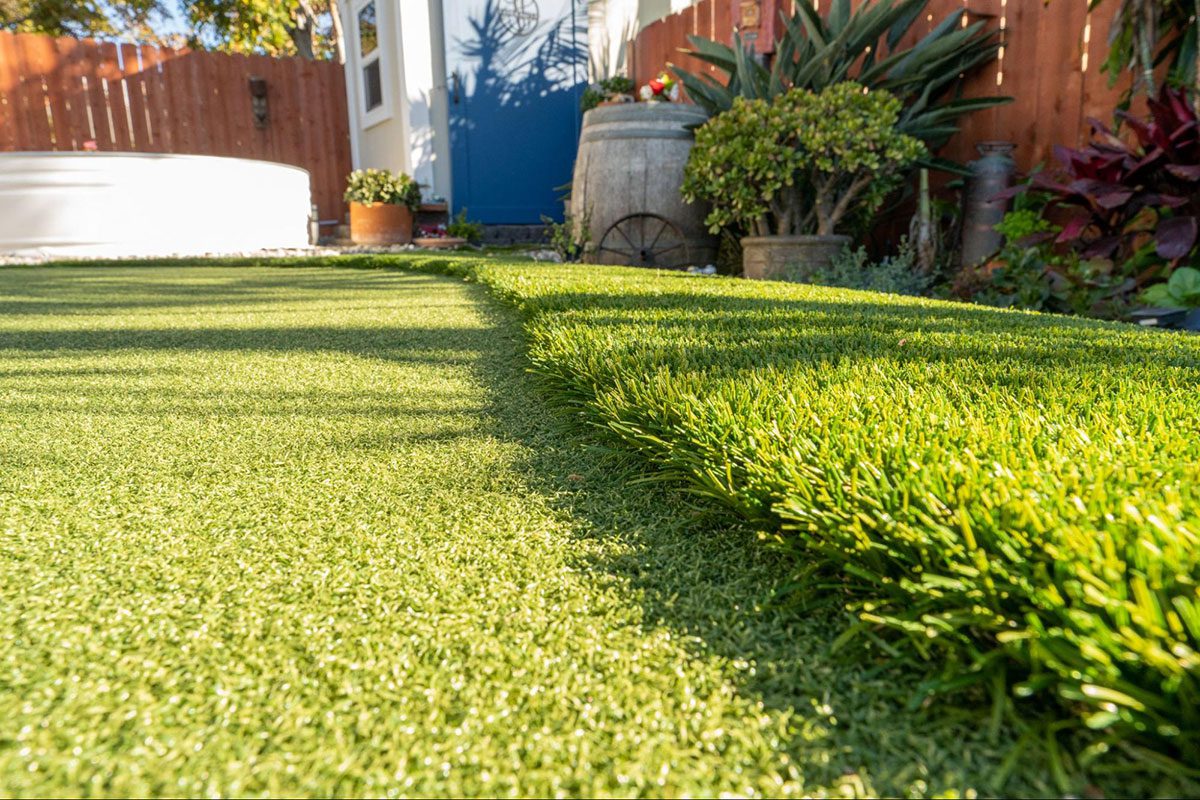Artificial grass has become an increasingly popular alternative to natural grass for homeowners and businesses alike. At Artificial Turf Supply, we understand that choosing the right turf for your space can be a tough decision. In this blog, we will explore the pros and cons of artificial grass, as well as its environmental impact. We hope that this information will help you make an informed decision about whether artificial grass is the right choice for your landscaping needs.
Pros of artificial grass
Low Maintenance: One of the biggest advantages of artificial grass is its low maintenance requirements. Unlike natural grass, which requires regular watering, mowing, and fertilizing, artificial grass simply needs occasional cleaning and brushing to maintain its appearance.
Water Savings: Another benefit of artificial grass is its water savings. In drought-prone areas, natural grass can be a major drain on water resources. With artificial grass, you can have a lush, green lawn without the high water bill.
Durability: Artificial grass is also more durable than natural grass, especially in high traffic areas. It can withstand heavy use without becoming damaged or worn down.
Versatility: Artificial grass can be used in a variety of settings, from residential yards to commercial landscapes. It is also a popular choice for sports fields and playgrounds.
Suitable for Challenging Settings: Artificial grass is a good option for areas with poor soil quality, harsh weather conditions, and high foot traffic. It can be installed in areas where natural grass would struggle to grow, such as shady spots or areas with limited access to water.
Where you can install artificial turf:
- Playgrounds
- Lawns and landscaping
- Indoor and outdoor sports
- Gym flooring
- Around pool decks
- For dogs and other pets
- Putting greens
Cons of artificial grass
Potential for Fading or Wear and Tear: One of the main drawbacks of artificial grass is its potential for fading or wear and tear over time. While high-quality artificial grass is designed to withstand the elements, it may still lose some of its color or texture after prolonged exposure to sunlight and foot traffic.
Initial Investment Cost: Artificial grass can be more expensive than natural grass, especially when it comes to installation costs. However, it is important to remember that the long-term savings on maintenance and water bills can make it a more cost-effective option in the long run.
Not Suitable for All Settings: Artificial grass may not be suitable for all settings, such as areas with high humidity or a desire for a natural look. Some people may prefer the look and feel of natural grass, and may not want to sacrifice that for the convenience of artificial grass.
Environmental impact of artificial grass
Water Savings: As mentioned earlier, one of the benefits of artificial grass is its water savings. By reducing the amount of water needed to maintain a green lawn, artificial grass can help conserve this precious resource.
Carbon Footprint: Artificial grass can also help reduce the carbon footprint of maintenance equipment. Lawn mowers and other maintenance equipment can emit pollutants and greenhouse gasses, contributing to climate change. By eliminating the need for these tools, artificial grass can help reduce their impact on the environment.
Synthetic Materials: However, it is important to consider the synthetic materials used in artificial grass. Some types of artificial grass are made from non-biodegradable materials that can take decades to decompose in landfills.
Impact on Ecosystems and Wildlife: Artificial grass can also impact local ecosystems and wildlife. Natural grass provides habitat for insects, birds, and other animals, and helps regulate the local environment. Artificial grass may not provide these same benefits.
Choosing the right artificial grass

When choosing artificial grass, it is important to consider a variety of factors to ensure that you select the right product for your needs. Here are some tips on how to choose the right type of artificial grass:
Size and Shape: Consider the size and shape of your space when choosing artificial grass. You may need to choose different types of turf for a small backyard versus a large sports field. Also, consider the shape of the area to be covered, as some types of turf may be better suited for irregular shapes.
Foot Traffic: Consider the amount of foot traffic that the area will receive. Some types of artificial grass are designed for heavy use, while others may be more suitable for low-traffic areas.
Environmental Considerations: Consider any environmental considerations when choosing artificial grass. Some types of turf are more eco-friendly than others, such as those made from recycled materials or those that require less water to maintain.
Quality: Finally, it is important to ensure that the artificial grass you choose is of high quality and will last for a long time. Look for products that are backed by warranties and that have been tested for durability and resistance to fading and wear and tear.
Is artificial grass right for you?
In summary, artificial grass has both pros and cons, and it is important to consider both when deciding whether it is the right choice for your landscaping needs. Artificial Turf Supply offers a wide range of high-quality artificial grass products that are designed to meet the needs of residential and commercial customers. By considering factors such as size and shape, foot traffic, environmental considerations, and quality, you can choose the right artificial grass product to create a beautiful and low-maintenance outdoor space.
Related resources:
- Where you can use artificial grass
- Cost of artificial grass
- How to choose the best artificial grass
- How to clean artificial grass
- Water bill savings with artificial grass
- How long does artificial turf last?
- Artificial turf supplies
- Artificial grass vs real grass
- Pros and cons of artificial grass
- Artificial grass installation guide
- Does artificial grass fade?
- Does artificial grass need water?
- How to install artificial turf



